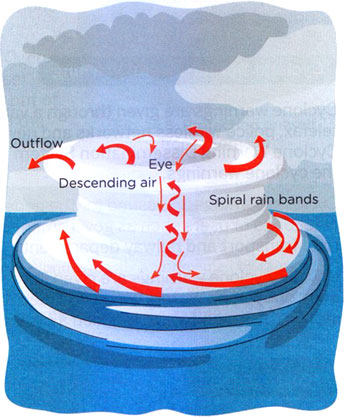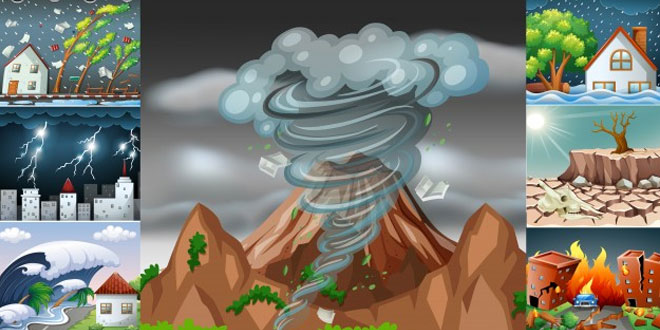Question: Why does wind swerve to one side instead of blowing straight?
Answer: If the earth had stood still, these winds would have blown straight but as the earth rotates the winds in the northern hemisphere swerve to the right and the winds in the southern hemisphere swerve to the belt.
Question: What are the hazard associated with a cyclone?
Answer: Cyclone are very destructive. Flooding is caused by the huge sea waves as they hit the coast and the accompanying rain further worsens the situation. Trees get uprooted, houses collapse and telecommunication lines get disrupted beading to heavy loss of life and properly.
Question: Describe the ‘eye of a cyclone’
Answer: At the center of the storm is a calm, cloudless area called the eye. The diameter may vary from 10 km to 30 km. There is no rain here and the winds are fairly light. The strongest winds (normally 150-250 km/h ) and heaviest rains are formed in thick clouds around the eye.
Question: How is the forecasting of cyclones done in India?
Answer: The Indian Meteorological Department studies the development and movement of cyclones. This is done with the help of the INSAT satellite and chain of Cyclone Detection Radars (CDRS) installed along the coastal belt of India. These radars can locate and track an approaching cyclone within a range of 400 km.
Question: What precautions are needed in the cyclone – prone areas?
Answer: Precaution for cyclone – prone regions:
- Listen to the TV and Radio weather bulletins regularly.
- Keep an emergency kit ready at home.
- Store enough food articles in waterproof bags.
- Store safe drinking water as contaminated water can cause diseases.
- Keep the phone numbers of hospitals, government agencies like police, relatives and friends handy.
Question: Draw a labelled diagram of the structure of a cyclone. Mark the direction of winds surrounding the eye.
Answer:

 Class Notes NCERT Solutions for CBSE Students
Class Notes NCERT Solutions for CBSE Students



Thanks for it. It help me very much in exam time.